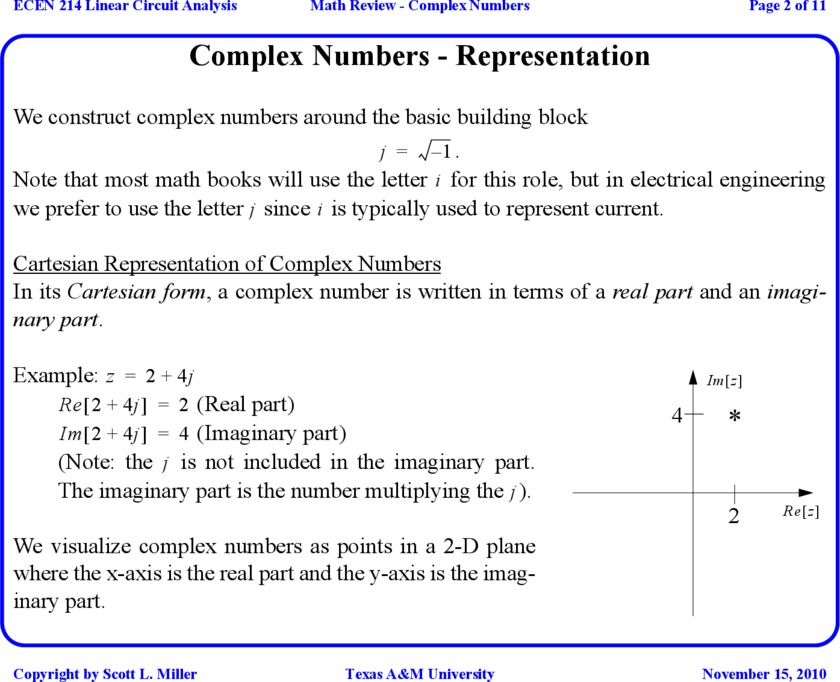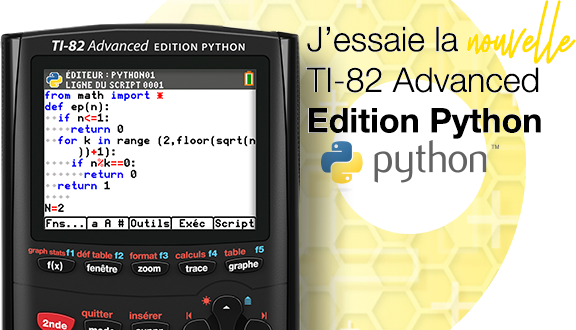Complex Variables
DownloadTélécharger
Actions
Vote :
ScreenshotAperçu

Informations
Catégorie :Category: mViewer GX Creator Lua TI-Nspire
Auteur Author: samjawaid
Type : Classeur 3.6
Page(s) : 9
Taille Size: 494.50 Ko KB
Mis en ligne Uploaded: 08/08/2017 - 02:40:26
Uploadeur Uploader: samjawaid (Profil)
Téléchargements Downloads: 98
Visibilité Visibility: Archive publique
Shortlink : https://tipla.net/a1123568
Type : Classeur 3.6
Page(s) : 9
Taille Size: 494.50 Ko KB
Mis en ligne Uploaded: 08/08/2017 - 02:40:26
Uploadeur Uploader: samjawaid (Profil)
Téléchargements Downloads: 98
Visibilité Visibility: Archive publique
Shortlink : https://tipla.net/a1123568
Description
ECEN 214 Linear Circuit Analysis Math Review - Complex Numbers Page 2 of 11
Complex Numbers - Representation
We construct complex numbers around the basic building block
j = –1 .
Note that most math books will use the letter i for this role, but in electrical engineering
we prefer to use the letter j since i is typically used to represent current.
Cartesian Representation of Complex Numbers
In its Cartesian form, a complex number is written in terms of a real part and an imagi-
nary part.
Example: z = 2 + 4j Im z
Re 2 + 4j = 2 (Real part)
4 *
Im 2 + 4j = 4 (Imaginary part)
(Note: the j is not included in the imaginary part.
The imaginary part is the number multiplying the j ).
2 Re z
We visualize complex numbers as points in a 2-D plane
where the x-axis is the real part and the y-axis is the imag-
inary part.
Copyright by Scott L. Miller Texas A&M University November 15, 2010
ECEN 214 Linear Circuit Analysis Math Review - Complex Numbers Page 3 of 11
Complex Numbers - Representation
Polar Representation of Complex Numbers
In its polar form, a complex number is written in terms of Im z
magnitude, r , and phase, . The polar form of a complex
4 *
number stems from Euler’s Identity,
r
e j = cos + j sin .
Multiplying both sides by a magnitude, r , produces
2 Re z
re j = r cos + jr sin .
Therefore, for a complex number with magnitude, r , and
phase, , we write the complex number in its Polar form as
z = re j and the Cartesian representation of the same com-
plex number would be
x = Re re j = r cos , y = Im re j = r sin .
The above equations show us how to convert from polar form to Cartesian form. The con-
version from Cartesian to Polar works out to be
y
r = x 2 + y 2 , = tan – 1 -- .
x
Copyright by Scott L. Miller Texas A&M University November 15, 2010
ECEN 214 Linear Circuit Analysis Math Review - Complex Numbers Page 4 of 11
Complex Numbers - Representation
Examples: Convert each of the following complex numbers from polar to Cartesian form.
(a) z = 2e j 4 (b) z = 3e –j (c) z = e j3 2
Im z Im z Im z
*
2 4
–3
Re z
* Re z Re z
*
3 3
2e j 4 = 2 cos --- + j2 sin --- 3e – j = 3 cos – + j3 sin – e j3 2 = cos ------ + j sin ------
4 4 2 2
= 2+j 2 = – 3 + j0 = – 3 = 0 + j –1 = –j
Copyright by Scott L. Miller Texas A&M University November 15, 2010
ECEN 214 Linear Circuit Analysis Math Review - Complex Numbers Page 5 of 11
Complex Numbers - Representation
Examples: Convert each of the following complex numbers from Cartesian to polar form.
(a) z = 1 + j (b) z = 2j (c) z = – 1 – 2j
Im z
(a) r = x2 + y2 = 12 + 12 = 2
*
y 1
= tan – 1 -- = tan –1 --- = ---
x 1 4 Re z
z = 1+j = 2e j 4
(b) r = x2 + y2 = 02 + 22 = 2 Im z
*
y 2
= tan – 1 -- = tan –1 --- = ---
x 0 2 Re z
z = 2j = 2e j 2
(a) r = x2 + y2 = –1 2 + –2 2 = 5 Im z
y –2
= tan – 1 -- = tan –1 ------ = 4.25rad
x – 1
Re z
z = – 1 – 2j = 5e j 4.25
*
Copyright by Scott L. Miller Texas A&M University November 15, 2010
ECEN 214 Linear Circuit Analysis Math Review - Complex Numbers Page 6 of 11
Complex Numbers - Arithmetic
Addition and Subtraction
It is easiest to add and subtract complex numbers in their Carte- Im z
sian from.
z 1 + z 2 = x 1 + jy 1 + x 2 + jy 2 = x 1 + x 2 + j y 1 + y 2 .
z1
z 1 – z 2 = x 1 + jy 1 – x 2 + jy 2 = x 1 – x 2 + j y 1 – y 2 . z2
z1 + z2 Re z
Visually, this works just like vector addition/subtraction. If you
are given complex numbers in polar form and you need to add or
subtract them, first convert them to Cartesian form, then add/subtract and then convert the
result back to polar form (if desired).
Multiplication and Division
It is easiest to multiply/divide complex numbers in their polar form
z 1 z 2 = r 1 exp j 1 r 2 exp j 2 = r 1 r 2 exp j 1 + 2 .
z1 r 1 exp j 1 r
- = ----1 exp j 1 – 2 .
---- = --------------------------
z2 r 2 exp j 2 r2
There is no visual interpretation of multiplication/division.
Copyright by Scott L. Miller Texas A&M University November 15, 2010
ECEN 214 Linear Circuit Analysis Math Review - Complex Numbers Page 7 of 11
Complex Numbers - Arithmetic
Multiplication and Division
You can multiply and divide complex numbers in the Cartesian domain, but it is a little
more complicated than doing the same in the polar domain.
Multiplication:
z 1 z 2 = x 1 + jy 1 x 2 + jy 2 = x 1 x 2 + j x 1 y 2 + x 2 y 1 + j 2 y 1 y 2
= x1 x2 – y1 y2 + j x1 y2 + x2 y1 .
Division:
z1 x 1 + jy 1 x 1 + jy 1 x 2 – jy 2 x1 x2 + j x2 y1 – x1 y2 – j 2 y1 y2
---- = ------------------ = ------------------ ------------------ = ------------------------------------------------------------------------
z2 x 2 + jy 2 ...
Complex Numbers - Representation
We construct complex numbers around the basic building block
j = –1 .
Note that most math books will use the letter i for this role, but in electrical engineering
we prefer to use the letter j since i is typically used to represent current.
Cartesian Representation of Complex Numbers
In its Cartesian form, a complex number is written in terms of a real part and an imagi-
nary part.
Example: z = 2 + 4j Im z
Re 2 + 4j = 2 (Real part)
4 *
Im 2 + 4j = 4 (Imaginary part)
(Note: the j is not included in the imaginary part.
The imaginary part is the number multiplying the j ).
2 Re z
We visualize complex numbers as points in a 2-D plane
where the x-axis is the real part and the y-axis is the imag-
inary part.
Copyright by Scott L. Miller Texas A&M University November 15, 2010
ECEN 214 Linear Circuit Analysis Math Review - Complex Numbers Page 3 of 11
Complex Numbers - Representation
Polar Representation of Complex Numbers
In its polar form, a complex number is written in terms of Im z
magnitude, r , and phase, . The polar form of a complex
4 *
number stems from Euler’s Identity,
r
e j = cos + j sin .
Multiplying both sides by a magnitude, r , produces
2 Re z
re j = r cos + jr sin .
Therefore, for a complex number with magnitude, r , and
phase, , we write the complex number in its Polar form as
z = re j and the Cartesian representation of the same com-
plex number would be
x = Re re j = r cos , y = Im re j = r sin .
The above equations show us how to convert from polar form to Cartesian form. The con-
version from Cartesian to Polar works out to be
y
r = x 2 + y 2 , = tan – 1 -- .
x
Copyright by Scott L. Miller Texas A&M University November 15, 2010
ECEN 214 Linear Circuit Analysis Math Review - Complex Numbers Page 4 of 11
Complex Numbers - Representation
Examples: Convert each of the following complex numbers from polar to Cartesian form.
(a) z = 2e j 4 (b) z = 3e –j (c) z = e j3 2
Im z Im z Im z
*
2 4
–3
Re z
* Re z Re z
*
3 3
2e j 4 = 2 cos --- + j2 sin --- 3e – j = 3 cos – + j3 sin – e j3 2 = cos ------ + j sin ------
4 4 2 2
= 2+j 2 = – 3 + j0 = – 3 = 0 + j –1 = –j
Copyright by Scott L. Miller Texas A&M University November 15, 2010
ECEN 214 Linear Circuit Analysis Math Review - Complex Numbers Page 5 of 11
Complex Numbers - Representation
Examples: Convert each of the following complex numbers from Cartesian to polar form.
(a) z = 1 + j (b) z = 2j (c) z = – 1 – 2j
Im z
(a) r = x2 + y2 = 12 + 12 = 2
*
y 1
= tan – 1 -- = tan –1 --- = ---
x 1 4 Re z
z = 1+j = 2e j 4
(b) r = x2 + y2 = 02 + 22 = 2 Im z
*
y 2
= tan – 1 -- = tan –1 --- = ---
x 0 2 Re z
z = 2j = 2e j 2
(a) r = x2 + y2 = –1 2 + –2 2 = 5 Im z
y –2
= tan – 1 -- = tan –1 ------ = 4.25rad
x – 1
Re z
z = – 1 – 2j = 5e j 4.25
*
Copyright by Scott L. Miller Texas A&M University November 15, 2010
ECEN 214 Linear Circuit Analysis Math Review - Complex Numbers Page 6 of 11
Complex Numbers - Arithmetic
Addition and Subtraction
It is easiest to add and subtract complex numbers in their Carte- Im z
sian from.
z 1 + z 2 = x 1 + jy 1 + x 2 + jy 2 = x 1 + x 2 + j y 1 + y 2 .
z1
z 1 – z 2 = x 1 + jy 1 – x 2 + jy 2 = x 1 – x 2 + j y 1 – y 2 . z2
z1 + z2 Re z
Visually, this works just like vector addition/subtraction. If you
are given complex numbers in polar form and you need to add or
subtract them, first convert them to Cartesian form, then add/subtract and then convert the
result back to polar form (if desired).
Multiplication and Division
It is easiest to multiply/divide complex numbers in their polar form
z 1 z 2 = r 1 exp j 1 r 2 exp j 2 = r 1 r 2 exp j 1 + 2 .
z1 r 1 exp j 1 r
- = ----1 exp j 1 – 2 .
---- = --------------------------
z2 r 2 exp j 2 r2
There is no visual interpretation of multiplication/division.
Copyright by Scott L. Miller Texas A&M University November 15, 2010
ECEN 214 Linear Circuit Analysis Math Review - Complex Numbers Page 7 of 11
Complex Numbers - Arithmetic
Multiplication and Division
You can multiply and divide complex numbers in the Cartesian domain, but it is a little
more complicated than doing the same in the polar domain.
Multiplication:
z 1 z 2 = x 1 + jy 1 x 2 + jy 2 = x 1 x 2 + j x 1 y 2 + x 2 y 1 + j 2 y 1 y 2
= x1 x2 – y1 y2 + j x1 y2 + x2 y1 .
Division:
z1 x 1 + jy 1 x 1 + jy 1 x 2 – jy 2 x1 x2 + j x2 y1 – x1 y2 – j 2 y1 y2
---- = ------------------ = ------------------ ------------------ = ------------------------------------------------------------------------
z2 x 2 + jy 2 ...












